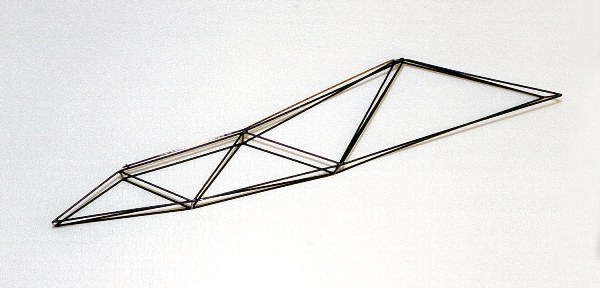The works of German metalsmith Georg Dobler are imbued with geometry; both in the construction of the forms and in the visual relationship between the forms and the body. Dobler received his masters in goldsmithing in 1979 in Pforzheim and thereafter founded an atelier with fellow goldsmith Winfried Krüger.[1]. In recent years he has worked as a Professor at the University of Applied Sciences and Arts in Hildesheim, Germany.
In the early eighties, Dobler’s architecturally inspired works gained recognition in the world of art jewelry for their stunning angular framework and presence on the human form. This brooch from 1983, constructed in steel wire and coated with black acrylic lacquer, is among Dobler’s early body of works notable for having the appearance of being at once planar and voluminous. The form of the brooch is visually deceptive and the triangular steel framework is slighter in depth than the lines suggest. Because of this illusion the brooch manages to appear architectural in dimension without being cumbersome when worn. In regard to Dobler’s oeuvre, metalsmith and gallerist Paul Derrez stated: “Wearability plays a subordinate role in brooches; even if it is not being worn, a brooch always maintains its distinctive character as an object.”[2]
Though there is certainly truth in this assertion, Dobler’s forms are only truly actualized when worn on the body.
The geometric construction of Dobler’s brooches may seem rigid, and cold but when applied to their intended site, the human form, the mathematical perfection of these forms compliment and highlight the subtle, organic geometry of the wearer’s body. In photographs, showing the brooch worn horizontally along the top of the shoulder, it is clear that Dobler is not just making small sculptures with wearability as an afterthought. Dobler’s brooches are able to stand on their own as gorgeous, masterfully constructed forms but are not fully realized until juxtaposed with the curvilinearity of the human body. Rather than standing in stark contrast to the organic lines of the human form, the works in this series highlight, frame and exalt the bodies that wear them.
[1] http://www.artaurea.com/jewelries/114-georg-dobler
[2] Paul Derrez, “Space and Structure” in Georg Dobler: Schmuck 1980-2000 ed. Georg Dobler, Etienne Girardet, Tomas Didier (Munchen: Galerie Spektrum, 2000), 15
